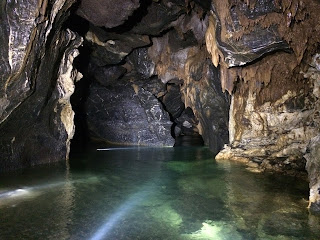The karst in the Quang Binh province of central Vietnam is notable for the extensive series of very large cave passages that drain through the blocks of limestone. Many of the caves are part of the Hang Phong Nha system. In March 2012, the British-Vietnamese Caving Expedition was fortunate to be able to explore Hang Va.
The entrance to Hang Va is a collapse in the floor of a small steep valley, with cliffs to the north. A descent of about 15m leads into a stream passage that averages 5m high and wide. The cave passage contains a stream throughout the dry season.Downstream leads after 400m to a sump, we believe this water flows into Nuoc Nut Cave, though it has not been confirmed scientifically.
A small passage entering the Hang Va streamway can be followed up to another small sump. This is believed to carry water from the flood stream that sinks at the bottom of the Wall of Vietnam in Hang Son Doong, about 900m away.
Upstream Hang Va continues for 350m through areas of rock collapse, until a high-level passage opens about 20m above. The streamway continues underneath for a further 300m to an upstream sump. The water comes from Khe Om, a stream which disappears into rocks on the surface.
Inside Hang Va, the upstream high-level passage above the flowstone climb and traverse is much larger that the streamway beneath; it is 20-30m wide and 10m high. Initially the passage slopes up over mud floors in dry gour pools. Further along the pools are partially filled with water. Within the wet and dry gours are the numerous conical calcite formations that have been named as the Tower Cones.
For more photos click here Hang Va Cave





























No comments:
Post a Comment